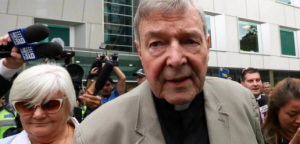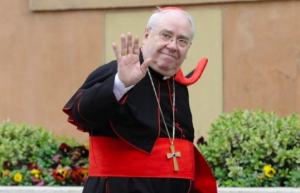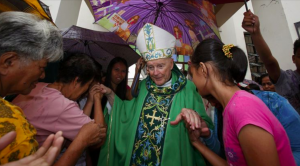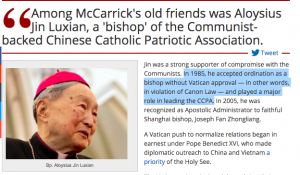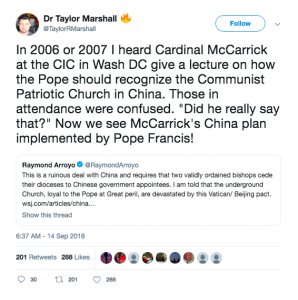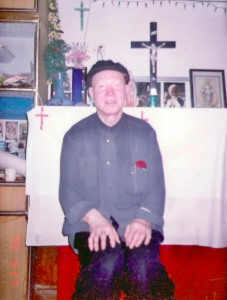Pell the conservative remanded to prison; Mr. McCarrick…
By Hilary White
…not so much.
I’m back. A friend has been visiting, and the “sex abuse summit” seemed like an unspeakable farce, so I guess I’ve been taking a couple of days off. And, as nearly always happens, the world I came back to is unrecognisably weirder.
Item 1: George Pell is going to prison following second trial conviction on dodgy evidence in Melbourne.
Now, lots of people are talking about the dodginess of the evidence and the trial procedures, and of the prosecutors’ motives for bringing it to a second “try-again” trial. But I don’t see a lot of people pulling the camera back. At least, they’re not pulling it back as far as Rome. They’re not asking the question, “Why did Pell – a hand-picked member of Bergoglio’s faded “C9” cardinals’ council, let’s not forget – get thrown to the Aussie dingos when so many others have been so fiercely protected?
Why did Pell not get the Barros/Inzoli/Errazuriz/Grassi/Karadima/Zanchetta/Danneels/Murphy-O’Connor/Maradiaga treatment of ardent papal protection? Why no vehement Bergoglian denunciations of the stupidity of the claims against Pell? Why no adamant, “I won’t say one word about this” from a plane presser? Could it have been due to something like this? _“The Vatican’s financial chief, Cardinal George Pell, has taken the unusual step of criticizing Pope Francis’ groundbreaking environmental encyclical, arguing the Catholic Church has “no particular expertise in science.”? _How many other little disagreements did Pell have with the boss?
Did he know Jorge’s reputation back in Argie as a vindictive maniac who loves him some sweet, sweet ice-cold revenge? Probably not.
What I’d like to know is what did Pell find in his – reportedly very thorough – investigations into and attempts at reform of the hot mess of Vatican finances:
In an article for Britain’s Catholic Herald Magazine to be published on Friday, Australian Cardinal George Pell wrote that the discovery meant overall Vatican finances were in better shape than previously believed.
“In fact, we have discovered that the situation is much healthier than it seemed, because some hundreds of millions of euros were tucked away in particular sectional accounts and did not appear on the balance sheet,” he wrote.
In the end, it turned out to be over a billion E’s that had just been squirrelled away. So, whose secret little money-stash did he threaten? Who was going to be in the soup for having, essentially, embezzled all that cash? To answer that question, we just have to find out who is now in charge of the money machine in the Vatican. We knew Pell was being set up for a fall when Bergoglio pulled the rug out from under his investigations allowing the external auditor Pell had brought in to be fired.
Was Pell getting too close to the financial doings of the APSA?
In July, 2016, Jorge pulled the authority for management of the Vatican’s assets from Pell, placing it back into the hands of the APSA, the Amministrazione del Patrimonio della Sede Apostolica. This is the Vatican’s treasury responsible for administering the property holdings of the Holy See, including a purchasing office, and overseeing a (very) large investment portfolio. In July 2016, Jorge issued a motu proprio that effectively shut down Pell’s reforms:
The body in charge of management and administration cannot be the same as the body in charge of oversight and vigilance. This point is underlined in a motu proprio approved by Pope Francis, which puts an end to months of internal arguments, making it clear that the task of administering the Holy See’s assets lies with APSA and is not being handed over to the Secretariat for the Economy…
After a significant adjustment period, Francis has decided that tasks relating to the management of immovable and movable assets and a big chunk of the administrative services to the Curia will be handed [back] to the Administration of the Patrimony of the Apostolic See, headed by Cardinal Domenico Calcagno. This relieves the Secretariat for the Economy headed by Cardinal George Pell, from these tasks.
In light of the disagreements between APSA and the Secretariat for the Economy…
That meant that from now on, all the money and assets were in the charge of this man, Domenico Calcagno. This was the Calcagno who had been under an inconclusive investigation for embezzlement over the loss of “several million Euros” from his former diocese. At this time the APSA was overseeing an estimated 10 billion Euros worth of assets, (though estimates have gone as high as 17). Formally, Pell still had “oversight and vigilance,” but with no power of enforcement that meant nothing.
Then in December, 2017, Jorge brought in Zanchetta who was on the run from Argentine authorities in relation to allegations of sexual abuse and financial misconduct. As he did early on with Jose Rodriguez Carballo, Bergoglio plucked his pal Zanchetta out of the way of legal trouble, giving him a Roman sinecure – in fact, inventing a whole non-existent job for him – in APSA.
In his book The Dictator Pope, Henry Sire wrote of the Calcagno/Pell clashes:
Cardinal Pell has never been a master of diplomatic style, and the Italians are unfamiliar with the figure of a blunt but honest Anglo-Saxon of whom an example had been thrust in their midst.
The opposition to Cardinal Pell has been headed by four cardinals who are interested not merely in stalling the financial reform but returning the Vatican structures to the position before Pell appeared on the scene. We may begin with Cardinal Domenico Calcagno, who has been president of APSA since 2011 and who is the most scandalous of the four. Gianluigi Nuzzi, in one of his more outspoken comments, describes Calcagno as “the scheming prelate and wily connoisseur of the Curia’s secrets”. Before being appointed to the Curia, Calcagno had been Bishop of Savona, where between 2002 and 2003 he ignored repeated instances of sexual violence against minors by one of his priests, simply moving him on to another parish. What is even more shocking is that Calcagno is still under investigation for real-estate dealings which harmed the diocese’s finances. It is a commentary on Francis’s pontificate that such a background is not thought incompatible with the holding of one of the key financial posts in the Vatican.
…
The leading scandal of the past four years has been the way in which APSA, under Cardinal Calcagno, has been able to regain its power. While media attention was being focused on IOR…it was not noticed that APSA itself has been operating as a parallel “Vatican Bank”, and it has escaped the reforms to which IOR is subject. APSA has long been managing accounts for private customers and opening coded accounts for them in Swiss banks (it is not known whether it is still going on). This has been a favourite resource for rich Italians, allowing them to put money into investment funds and avoid paying tax. In these services, APSA acted in competition with its own sister institution in its quest for customers, with officials being known to assure investors that APSA would outperform IOR.
There is reason to believe that all along it has been APSA rather than IOR that was the real factory of criminality in the Vatican finances. Under Cardinal Calcagno APSA has shrugged off the attempted reforms with insolent ease, while it has also defied the new economy rules by engaging expensive external consultants and lawyers to help it seal its murky past. As for Pope Francis, he has repeatedly been made aware of all this but has taken no action.
So, today Calcagno is comfortably retired (with Bergoglian insider and prize rat-bag Nunzio Galantino replacing him at APSA) and Pell is in prison.
I’m afraid I find all this rather too much for coincidence.
All the headlines that pop up lately in a Google search for “Pell Vatican finance” mostly resemble the BBC pile-on with headlines like, “Cardinal Pell: Poisoned power at the top of the Church”. But dig a few pages down and it wasn’t that long ago that we were hearing about stuff like this: “The days of ripping off the Vatican are over.” an op-ed in the Herald where Pell explained that casual financial malfeasance was just the normal procedure for the Vatican’s Curia who “were following long-established patterns. Just as kings had allowed their regional rulers, princes or governors an almost free hand, provided they balanced their books, so too did the popes with the curial cardinals (as they still do with diocesan bishops).”
Pell explained that questions about financial accountability were simply not the kind that would occur to the Italian Curial mind (something everyone who has lived here a while understands) but that are the first thing we “Anglos” think of. It’s similar to the wacky Anglo notion that the public should be able to trust the journalists to tell them the truth about the Vatican – a bit of a running joke in Italy; we’re naive simpletons, you see. A scrupulously honest and forthright man is considered at best a fool in this country.
Pell’s next sentence might give us a hint as to why Bergoglio was so keen to see him off: “Because of the size of the Catholic community, with about 3,000 dioceses spread through every continent, the principle of subsidiarity – that is, local management of diocesan and religious order finances – is the only option.”
As we know, the entire Bergoglian programme has been aimed at centralisation of control, cronyism and anti-transparency. And as we all saw last week, the current set of papal insiders are a school of squid: blowing ink to confuse their enemies while they make a get-away. Pell’s emphasis on financial transparency, clarity and subsidiarity – as well as his intolerably “Anglo-sassone” forthrightness – was never going to go over well.
Henry Sire again:
As an Anglo-Saxon, George Pell had the assumptions of a parliamentary culture: the reform of the Vatican structures had been decreed by legal authority, the officials would obviously respect the policy and work to carry it out, and all that remained to do was to get on with it. That mistake was not made by Cardinals Parolin [Secretary of State], Calcagno, Versaldi and Bertello. They were Italians, and where they came from there was a wide difference between what an administration said it was going to do and what it had any intention of doing. Above all, the historic lessons of the Italian princely courts, not least the papal court, were in the marrow of their bones. In that world, results were not achieved by debate and administrative resolutions, they were gained by having the ear of the monarch, attending him day by day, and dropping plausible advice constantly into his ear. That is the path which they have very successfully followed.
Andrea Tornielli – the pope’s main cheerleader in the Italian press – helpfully explained (1st July, 2017) that Pell was stepping on a LOT of toes:
“Pell enters the Roman Curia as an elephant in a glassware, in charge of administering a drastic cure to an institution considered by many, especially in the Anglo-Saxon world, to be severely sick. His ways are offhand, his attitude harsh in his centralizing mission. It is obvious to many he is not so good at working collectively and at taking into account rituals, customs, traditions of Curial diplomacy.
“Finally, it should not be forgotten that Pell was among those with the most conservative views on the issues of marriage and family in the last Synods.”
And we know Bergoglio never forgets.
In any case, it seems that Pell is well out of the way and though his office still exists – the Secretariat for the Economy – with the man himself not returning any time soon to Rome, business (ahem) can carry on peacefully as usual.
Item 2: Uncle Teddy McCarrick — whose guilt in the accusation of molestation of a minor of about the same vintage no one questions — isn’t.
Meanwhile, the many, many, MANY times-guilty rapist, molester and sexual harrasser “Uncle Teddy” McCarrick is living in comfortable retirement, enjoying the financial independence that comes with a lifetime being close to the great and powerful:
“There’s got to be basic sustenance. You can’t turn an almost-89-year-old out on the street,” said Susan Gibbs, who served as McCarrick’s spokeswoman when he was archbishop of Washington. She noted that the decision is now in part McCarrick’s own; for the first time since he entered the seminary and then served 60 years as a priest and bishop, he is not bound to go where the church tells him to go. “Technically, he could walk out the door right now. In the church, you make a promise of obedience. If you’re not a priest, you don’t have that anymore. But in his heart, he’s still there. He’s still a priest in his heart. That’s all I think he knows.”
So, is there a cut-off age for criminal prosecution for sexual crimes? Because I can certainly think of a suitable residence – that, as I understand it, provides “suitable sustenance” – where Mr. McCarrick could end his days. And it ain’t Turks and Caicos.
Did anyone really imagine that the man through whose hands reportedly tens of millions flowed into the Vatican’s shady banking apparatuses (cf: above), wouldn’t have a nest-egg put aside for emergencies?
Yeah… no.
Ahead of an expected decision in the case of Archbishop Theodore McCarrick, new details have emerged about his likely financial status in the event that he is laicized.
Sources close to the former cardinal told CNA that McCarrick has previously declined an income from the Church, and that he has private means of support in place.
As of this writing, the latest information is that Mr. McCarrick is living in a Franciscan friary:
McCarrick resides at St. Fidelis Friary in the city of Victoria, the archdiocese said in a statement, adding that “respect for the privacy of this arrangement is requested” out of consideration for the peace of the community of the friars who live there.
Victoria is in a rural area of Kansas and has a population of about 1,200. The website for the friary, which is in the Diocese of Salina, lists its residents as five priests and one religious brother.
I have had information privately that the people of the diocese of Victoria, Kansas, are not terribly happy about having the now-completely unaccountable McCarrick, man of private means, against whom for some reason civil authorities are thus far not considering charges, living in a friary close to a school. The former cardinal’s name does not appear on the website of the friary, and local people were not informed by the diocese that the career-molester was living near their kids.
Meanwhile, the McCarrick legacy continues, both in the network of cover-ups for homosexual abuse of seminarians and others and in the Vatican’s trade deal with China.
What was the job for Pope Bergoglio after the pope had lifted the mild sanctions placed on McCarrick by Benedict XVI? Oh, just his personal ambassador to China.
Over 20 years, Archbishop McCarrick traveled to China on at least eight occasions, sometimes staying in a state-controlled Beijing seminary, often serving as an unofficial bridge between the Vatican and Chinese government-appointed bishops until 2016.
The National Catholic Reporter, back in 2014, was giddy with joy over the cardinal’s rehabilitation by Bergoglio and his work in China:
…[T]he cardinal was soon back at his guest room in the U.S. seminary in Rome when the phone rang. It was Francis. The two men had known each other for years, back when the Argentine pope was Cardinal Jorge Bergoglio, archbishop of Buenos Aires. McCarrick assured Francis that he was doing fine.
“I guess the Lord isn’t done with me yet,” he told the pope.
“Or the devil doesn’t have your accommodations ready!” Francis shot back with a laugh.
…
the exchange also says a lot about the improbable renaissance McCarrick is enjoying as he prepares to celebrate his 84th birthday in July.
McCarrick is one of a number of senior churchmen who were more or less put out to pasture during the eight-year pontificate of Pope Benedict XVI. But now Francis is pope, and prelates like Cardinal Walter Kasper (another old friend of McCarrick’s) and McCarrick himself are back in the mix and busier than ever.
McCarrick in particular has been on a tear in the past year, traveling to the Philippines to console typhoon victims and visiting geopolitical pivot points such as China and Iran for sensitive talks on religious freedom and nuclear proliferation.
…
Francis, who has put the Vatican back on the geopolitical stage, knows that when he needs a savvy back-channel operator, he can turn to McCarrick…
CNA reported in September 2018:
Over 20 years, Archbishop McCarrick traveled to China on at least eight occasions, sometimes staying in a state-controlled Beijing seminary, often serving as an unofficial bridge between the Vatican and Chinese government-appointed bishops until 2016.
Prior to allegations of sexual abuse and harassment becoming public this summer, the former cardinal had been an outspoken proponent of a deal between Chinese President Xi Jinping and the Church under Pope Francis, according to Chinese reports.
“I see a lot of things happening that would really open many doors because President Xi and his government are concerned about things that Pope Francis is concerned about,” McCarrick told The Global Times, in an exclusive interview in Feb. 2016.
Maniacal dictators bent on creating a totalitarian superstate flock together, I guess.
_McCarrick last visited China in 2016 — a trip he described as a meeting with “old friends.”_
Thing to remember is, though, that 20 years is a long time, and if that’s true he’d been working on the “unconscionable” Vatican/China deal since the days of Jay-pee-too-we-wuv-yoo, the putative “anti-communist” pope.
Both the State Department and Chinese media recorded a 1998 visit to China by Archbishop McCarrick…Chinese media reported that McCarrick paid a visit to the National Seminary in Beijing in 1998…In Aug. 2, 2003, the South China Morning Post reported that McCarrick ‘spent three days in Beijing earlier this week on what was ostensibly a private visit’.”
McCarrick was “the first cardinal from a western country to visit the mainland since relations between China and the Vatican turned frosty after a dispute over canonisation in October 2000,” the article continued.
Unfortunately, we have shown before how John Paul II’s much-lauded anti-communist work didn’t extend itself much outside the borders of Poland. I’ll never forget learning that John Paul’s “special ambassador” to China, the noisesome Roger Etchegaray, had met with Chinese officials and praised them for their sensitivity, and told them, “There aren’t two churches in China, but one Church with two faces...” Yah…Got that right at any rate.
I’ll just leave you with Church Militant’s video report on the origins of McCarrick’s close relationship with the Chinese communists.
And introduce you to Bishop Gao Kexian:
The last Chinese Catholic bishop out of prison is Giovanni Gao Kexian. He was under arrest since 1999, in an unknown location. Last August his family received his lifeless body.
And
He was a prisoner for over 5 years. Religious comforts were denied to him. He was buried in solitude, without the presence of faithful and relatives.
~
